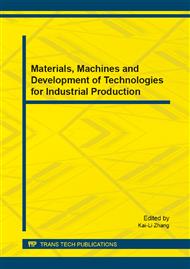[1]
Wang Chenxia. Modern Palm-print Diagnosis[M]. Lanzhou. Gansu Ethnic Publishing House. (1995).
Google Scholar
[2]
Yuan Weiqi & Feng Suyue. The Study on the Relationship between Distance and Image Clarity in Palm-print Shooting [J]. Microcomputer and its application, 2011, 30(8): 36-38.
Google Scholar
[3]
Pei Yu & Liu Hailin. The application of Kernel Discriminate Analysis in Palm-print Recognition[J]. Chinese Journal of Quantum Electronics, 2009, 26(6): 647-653.
Google Scholar
[4]
Jiajun Wen, Yan Chen. Appearance-based representative samples refining method for palm recognition [J]. Optical Engineering, 2012, 51(7): 077203-1-077203-9.
DOI: 10.1117/1.oe.51.7.077203
Google Scholar
[5]
Bao Qiugui, Lin Xirong, Xiong Shenzhuo et a1. The Study of the Palm-print Image Processing Method[J]. The Application of Computer, 2003, 23(12): 82-84. Qian Ying, Li Weihua. The Application of Random Selection of ROI Method in Palm-print Recognition[J]. Digicom, 2012, 39(4): 70-72.
Google Scholar
[6]
Zhang Ze, Shu Wei, Rong Gang et a1. The Automatic classification method based on the direction of ridges of palm-print[J]. Journal of Tsinghua University (Natural Science Edition), 2002, 42(9): 1222-1224.
Google Scholar
[7]
Journal of computer science and Technology (English version).
Google Scholar
[8]
Lu Guangming & Liao Qingmin. The Independent component analysis for palm-print recognition method based on wavelet decomposition[J]. The Application of Computer, 2007, 27(4): 913-915.
Google Scholar
[9]
Guo Jinyu, Kong Xiaoguang, Li Yuan et a1. Palm-print recognition based on multi-linear principal component analysis and FLD[J]. The research and application of computer, 2010, 27(11): 4398-4400.
Google Scholar
[10]
Gao Xin, Liu Chongjin, Feng Jufu et a1. T type structure of an adaptive algorithm of palm-print partition[J]. Journal of Computer Aided Design & computer graphics algorithm, 2011, 23(9): 1463-1467.
Google Scholar
[11]
Shu Wei, Rong Gang, Bian Zhaoqi et a1. The automatic palm-print datum point detection based on the projection in the direction[J]. Journal of Tsinghua University (Natural Science Edition), 1999, (1): 98-100.
Google Scholar
[12]
Gayathri, R.,P. Ramamoorthy. Palmprint Recognition using Feature Level Fusion[J]. Journal of computer sciences, 2012, 8(7): 1049-1061.
Google Scholar
[13]
Li Zhen, Hu Wenle, Zeng Yanjun et a1. Palm-print Image Processing in the Detection and Analysis System of Nondestructive Tumor Striae[J]. China bioengineering medical report, 2003, 22(5): 448-452, 472.
Google Scholar
[14]
Shu Wei, Rong Gang, Bian Zhaoqi. The Research on Automatic Identification Method Using the Palm-print[J]. Tsinghua Science and Technology (Natural Science Edition), 1999, (1): 95-97.
Google Scholar
[15]
Lin Sen & Yuan Weiqi. The Study on the Method of Normalized Deformation Palm-print Based on Demons Algorithm[J]. Chinese Journal of scientific instrument, 2012, 33(1): 62-68.
Google Scholar
[16]
Jiwen Lu, Yap-Peng Tan. Improved discriminant locality preserving projections palmprint recognition[J]. Neurocomputing, 2011, 74(18): 3760-3767.
DOI: 10.1016/j.neucom.2011.06.024
Google Scholar
[17]
Qin, A.K., Suganthan, P.N., Tay, C.H. et al. Personal Identification System based on Multiple Palmprint Features[C]. /Control, Automation, Robotics and Vision, 2006 9th International Conference on; Singapore. 2006: 1-6.
DOI: 10.1109/icarcv.2006.345257
Google Scholar


